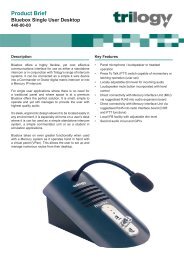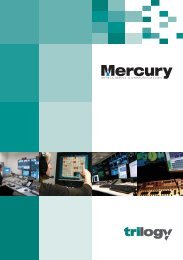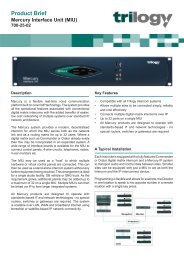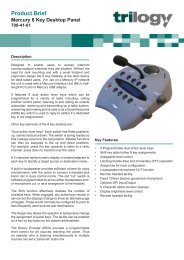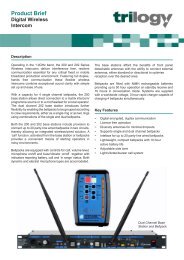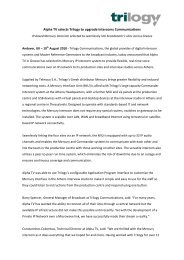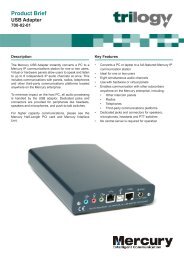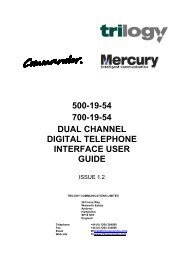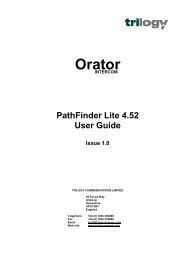PathFinder Software Configuration Guide - Trilogy Communications
PathFinder Software Configuration Guide - Trilogy Communications
PathFinder Software Configuration Guide - Trilogy Communications
- No tags were found...
Create successful ePaper yourself
Turn your PDF publications into a flip-book with our unique Google optimized e-Paper software.
19.3 <strong>Software</strong> <strong>Configuration</strong> Overview<strong>PathFinder</strong> Version 4.22 User <strong>Guide</strong>Each matrix has its own local PathfFinder database. Just as before, this carries all of thedata relating to inter-panel communication, 4 wire circuits, local groups, conferences etc.This is defined in exactly the same way as previous <strong>PathFinder</strong> versions. A prior workingknowledge of the basic steps of <strong>PathFinder</strong> programming is assumed. Before starting anynetwork related configuration, you should be familiar with:• System Overview• Panel <strong>Configuration</strong>: defining and targeting keys.There are a number of extra database tables solely related to networking facilities. Thesedefine the following: -• System Number• Network Handles• Remote TargetsThe software configuration is a six-stage process.• Plan the LAN by choosing appropriate system names and numbers. See section19.4.• Complete the System Overview, adding information relevant to the physical layout ofthe matrix port allocation, this includes panel types, 4 wire ports, telephone ports,logic cards and network ports where appropriate. See section 19.5• Add local matrix functionality. See section 19.6• Define local Network Handles. See section 19.7• Define Remote System Targets. See section 19.8• Continue programming panel key layouts by adding keys, which target other (remote)systems. See section 19.9.The system can be configured with three different network port types. These are:• Network Port Free Pool.As the name implies, these network ports are used on a “first available” basis. Ifcommunication between two systems is required, the first available free port will beallocated for the duration of that conversation.• Network Port Dedicated.The Dedicated network port allows a panel on System A not to be restricted by “firstavailable” basis of Free Pool networking and be guaranteed access to System B viathe E1 link.• Network Port 4 wire.The 4-wire Network port behaves in similar way to a copper wire connection from a4-wire port on System A to a 4-wire port on System B.These subjects are discussed in the following sections.Page 108 of 108 Issue 1 <strong>Trilogy</strong> <strong>Communications</strong> Limited




